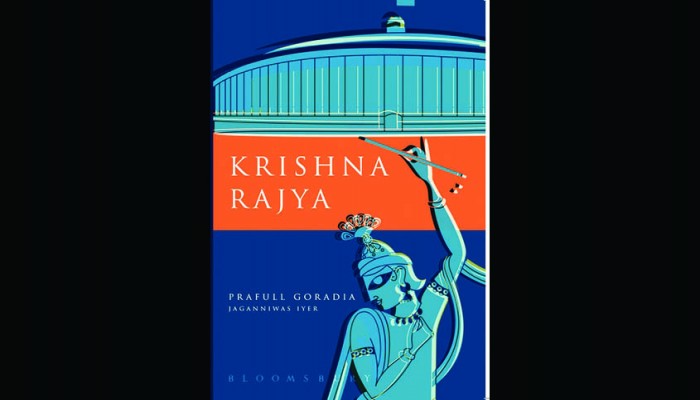Review of Krishna Rajya – by Sri Prafulla Goradia and Sri Jaganniwas Iyer
- In Book Reviews
- 12:16 AM, Aug 12, 2018
- Shashank Davanagere
When I first heard of the book, Krishna Rajya, I was intrigued. So far in my life I heard only about Rama Rajya and Krishna Gita, hence, my fascination. What a ride it’s been!! From the birth of Krishna to how he had the vision to unify India, against all odds, to the lessons we can learn from it, the book encompasses many of these things and more.
Sri Prafulla Goradia, an entrepreneur and former BJP member brings about earthy wisdom to the current parliamentary form of governance practiced in our country. Joining him in this journey, with his exhaustive knowledge of itihaasas, and Mahabharata in particular, is Sri Jaganniwas Iyer. The result is a wonderfully written, full of anecdotal and factual stories – Krishna Rajya.
There is a new trend in the Indic Literature world – that of humanizing the Gods, and Krishna Rajya follows that path. For a thesis about Rajyangam / politics, this has a tremendous multiplier effect. If we consider Krishna as God then we may feel that the things He had accomplished came to fruition just because He is God. But when you make Him human and then view his accomplishments thru that lens then it gives us hope that we can also achieve them! Krishna Rajya is macro view of political achievements of Krishna, as a human.
Krishna’s Strategy
I always thought of Krishna as strategist par excellence and have always looked at him as Sampoorna Avataram, but his actual brilliance comes to forte when he is seen as a human. Killing Kamsa was just the beginning of his vision. Once Kamsa was killed, it put Krishna (and Balarama) directly in confrontation with the biggest bully – Jarasandha. Krishna & Balarama fought 17 battles with Jarasandha before making the tactical decision to abandon Mathura and move to Dwaraka. It takes guts and a long term vision to even envision such a drastic move. When he is asked if the move is a temporary one, Krishna is prescient to say that it is a permanent move!! He recognized the weakness of Yadavas, strengths of Jarasanda in-spite of his 17 defeats and was cognizant of the fact that the Yadavas couldn’t keep with the repeated assaults. He got called “ranchod” – or someone who runs away from the battle, but his ego was unperturbed. He put the Yadavas ahead of his ego.
This particular incident reminded me of a particular leader who got called murderer, maut-ka-saudagar etc. but he does seem to put Bharat ahead of his ego. For the record, I am not calling the leader as Krishna, just that he, like Krishna, doesn’t seem to care about what people call him. Continuing with the story, Krishna recognizes that Yadavas don’t have what it takes to protect the Dharma all over Bharata, especially by taking on such Asuras as Jarasandha, Duryodhana and Narakasura. Jarasandha took the help of a foreigner – Kaalyavana – to overcome the Yadavas. Krishna with his meticulous planning and strategy negates the threat by killing Kaalyavana. Now there are some who say Kaalyavana was not a foreigner per se but the fact remains that he was from the established borders of Bharata, so can be considered as a foreigner. He identifies Pandavas as those who are best positioned to take on the Asuras, protect and propagate Dharma. Pandavas being his cousins just helped cement the relationship. Krishna then guided Pandavas through thick and thin. He made them establish a new capital – Indraprastha on the banks of Yamuna. He forced Yudhishtira to do Raajasuya yagna. This was done with the implicit intention of gaining allies for the Pandavas in their quest to establish their rule over all of Bharata.
Krishna used this opportunity to negate the threat of Jarasandha. He did not want to face Jarasanda’s army in the open and cause more hardships to everyone involved, so he [thru Bheema] challenged Jarasandha for a wrestling bout wherein the biggest threat to Dharma in Bharata was removed. Krishna then removed the other adharmic challenger at Kaamaruupa – Narakasura by mounting a surprise attack on him. Thus with the two biggest threats removed, the Raajasuya yagna was complete with the rest of Bharata agreeing to the suzerainty of Yudhishtira. All his efforts to get the Pandavas subsume their cousins at Hastinapura without a major war came to a naught as Yudhishtira agreed to the game of dice. Krishna reprimanded Yudhishtira for his misinterpretation of Dharma. After the end of the exile when it was evident that Duryodhana was not going to return Indraprastha to the Pandavas, and war seemed imminent, it was Krishna who went on the last ditch effort to avoid it.
Krishna knew that his efforts would be futile, but nevertheless went ahead so that future generations wouldn’t hold the Pandavas responsible for not doing their best in avoiding the war. The world needed to know that Pandavas were willing to go that extra mile to prevent the holocaust but their enemies were not. [As an aside, this also looks similar to giving peace another chance by a particular leader.] We all know that happened after Krishna’s raaya-baaram failed. Even during the Kurukshetra war, it was the constant guidance of Krishna that saved the Pandavas. When Arjuna was unable, scratch that, unwilling to take on Bhishma, it was Krishna who counselled him to do it along with Shikandi. When Dronacharya was wreaking havoc on the Pandava army, it was Krishna again who helped them devise the strategy to overcome him. When Karna’s chariot was stuck and suddenly he remembered Dharma and ethics, it was again Krishna who propelled Arjuna to lift his Gandivam and kill Karna off!! In all these various doings, Krishna never wavered from Dharma. As Arjuna says “यतः कृष्णस्ततो धर्मो यतो धर्मस्ततो जयः” – Dharma is where Krishna is, and Victory is there where Dharma is!!
Krishna’s Strategy in modern times
In the above section, I have tried to cover some of the major events towards the Kurukshetra war. The book goes into details of all these (and more) events, at the same time reminding us about how the niti is relevant even now. It goes onto show how Krishna never wanted to be the overlord after all these. It also details how Krishna knew that save Pandavas the adherence of other rulers to the principles of Dharma was at best, tenuous. Thus the most reluctant ruler, Yudhishtira became the Emperor of India; reluctance brought on not by lack of power or ability, but by the constraints of Dharma.
The book then goes on to compare at a very high level the basic tenets of Western philosophy, on which our current constitution is based upon, and Indian philosophy which has been defined and refined over many thousands of years. The Western thought process is based off Plato’s Republic and works well for those adapted to it. When applied to our country, where the foundation is not Plato’s Republic but Veda Vyasa’s Mahabharata [i.e. Dharma], it causes schism in what people inherently believe and what they are told to follow. Having seen this from close quarters during his time as Member of Rajya Sabha, Sri Prafulla Goradia suggests that we should seriously consider rewriting our Constitution.
When Mahabharata could be rewritten [it started as Jaya then became Bharata and then finally the epic Mahabharata], why our Constitution can’t be rewritten, is the crux of the argument as proposed by the authors. This is a very valid question that they have raised. They suggested that instead of basing our Constitution on Western imports, maybe it is time to redo it, this time By Indians, and For Indians, based on Indic Dharma.
While the book does a wonderful job in taking the reader thru the complex history, I wish the same treatment was given to the most important question they raised. It almost looks likes the authors came close to the print deadline by the time they retold the Mahabharata. I wish they had taken their time to put two and two together by deriving lessons from Krishna Rajya and applying it to the process of rewriting the Constitution. Maybe it was their intent of just raising the question, if so then they have done a phenomenal job. Overall, a wonderfully written book that introduces us to what Krishna Rajya meant and the work that went into establishing one. Perhaps it is time for us, Indics, to start relooking at Krishna Rajya in more earnest than the ideal world of Rama Rajya. A lot we can learn and apply since, after all, Krishna offers practical solutions to live and adhere to Dharma in these imperfect times.
Disclaimer: The opinions expressed within this article are the personal opinions of the author. MyIndMakers is not responsible for the accuracy, completeness, suitability, or validity of any information on this article. All information is provided on an as-is basis. The information, facts or opinions appearing in the article do not reflect the views of MyindMakers and it does not assume any responsibility or liability for the same.







Comments